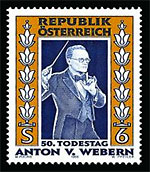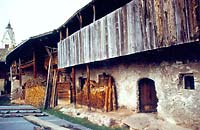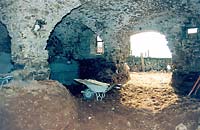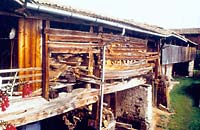The History of MASAVOI
The first written mention of the once vast farmstead was in the year of 1410 as "Egghof" with Peter Weber.In 1684 Peter Weber, a descendant by the same name sold half of the farmstead to a Savoy from the to the south lying Cembratal, who in turn made a gift of this half of the homestead to his son Caspar Savoy, the founder of the Altreier Savoy tribe and Savoy farm, later then to be divided into Lower and Upper Savoy. The same Peter Weber had three sons. Georg became the customs chief controlling the floating of logs on the river Etsch for Leifers and Brandzoll and received in 1705 in his capacity as Customs Officer to Leifers and Branzoll" from the Emperor for "extraordinary service" the title "von Webern zu Treuenhausen und Postfedern" plus certificate of title as coat of arms.This honour was deemed valid for him, his two brothers, his father and all direct descendents.The famous Vienna twelve-tone composer and pupil of Arnold Schönberg, Anton von Webern (1883 - 1945), was verifiably a direct descendent of the today still existent Branzoll line of the von Webern.
The same Peter Weber had three sons. Georg became the customs chief controlling the floating of logs on the river Etsch for Leifers and Brandzoll and received in 1705 in his capacity as Customs Officer to Leifers and Branzoll" from the Emperor for "extraordinary service" the title "von Webern zu Treuenhausen und Postfedern" plus certificate of title as coat of arms.This honour was deemed valid for him, his two brothers, his father and all direct descendents.The famous Vienna twelve-tone composer and pupil of Arnold Schönberg, Anton von Webern (1883 - 1945), was verifiably a direct descendent of the today still existent Branzoll line of the von Webern.
Franz Weber from Egghof, son of Johann von Webern, married Maria Barbara Savoy, thereby marrying into the Lower Savoy farm, as her father Peter Savoy had no male heirs.Their son, the 1930 deceased Johann Simon Weber, who also had no male heirs, was my great grandfather and father of my beloved grandmother "granny" Anna, married Abram.
Masavoi today was formally the agricultural building of the Lower Savoy farm. (Spelling with 'i' rather than' y' established itself through the Altrei Savois since 1850)
(Source: Dr. Heinz Abram - Heimatbuch Altrei 2006)
 |
 |
 |
In January 1999 I began modifications on the Lower Savoi agricultural building, whose ground floor had housed the stalls for horses and cows (large cross-vault) and sheep (barrel vault). In the years between the wars my father had converted the sheep stall into a joinery. The upper floor was used in part for a wood depot for the joinery, but mostly as a hay barn for the farm which was still in operation until the end of the '60s. Still within the walls is that cozy secure feeling during the long winter evenings after school while feeding in the cow shed, the rhythmic grinding sound of the cows munching as soothing relaxing music to the ears….
Since 2004, together with my long term colleague and dear friend Anna Neil-Raduner from Basel, with whom in creative and fruitful collaboration I've been organizing further education workshops for rolfers, dancers and movement professionals.With her enthusiasm for the project, her creativity and her appreciation for aesthetic, already since the final phases of the building modifications she has been of invaluable assistance. In the meantime Anna is mostly occupied with an interesting project of her own at Lake Geneva. Time will tell how we'll pattern our further cooperation.
Certain is that further education workshops at Masavoi are continuing, perhaps though with some shift in focus: the work with professional musicians with Musireset®!
Currently I am planning movement classes for professionals in the areas dance, theater and sport; advanced classes for clients and certainly further theme-specific courses for rolfers.

